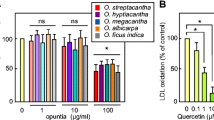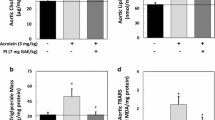Abstract
Dietary intake of Opuntia species may prevent the development of cardiovascular diseases. The present study was designed to characterize the biological antioxidant and anti-inflammatory properties of Opuntia species and to investigate whether Opuntia cladodes prevent the development of atherosclerosis in vivo, in apoE−KO mice. The effects of the two Opuntia species, the wild Opuntia streptacantha and the domesticated Opuntia ficus-indica, were tested on the generation of intra- and extracellular reactive oxygen species (ROS) production and kinetics of the LDL oxidation by murine CRL2181 endothelial cells and on the subsequent inflammatory signaling leading to the adhesion of monocytes on the activated endothelium and the formation of foam cells. Opuntia species blocked the extracellular ROS (superoxide anion) generation and LDL oxidation by CRL2181, as well as the intracellular ROS rise and signaling evoked by the oxidized LDL, including the nuclear translocation of the transcription factor NFκB, the expression of ICAM-1 and VCAM-1 adhesion molecules, and the adhesion of monocytes to CRL2181. In vivo, Opuntia significantly reduced the formation of atherosclerotic lesions and the accumulation of 4-hydroxynonenal adducts in the vascular wall of apoE-KO mice, indicating that Opuntia cladodes prevent lipid oxidation in the vascular wall. In conclusion, wild and domesticated Opuntia species exhibit antioxidant, anti-inflammatory, and antiatherogenic properties which emphasize their nutritional benefit for preventing cardiovascular diseases.




Similar content being viewed by others
References
Arai H (2014) Oxidative modification of lipoproteins. Subcell Biochem 77:103–114
Aviram M (2001) Review of human studies on oxidative damage and antioxidant protection related to cardiovascular diseases. Free Radic Res 33(Suppl):S85–97
Baños G, Pérez-Torres I, El Hafidi M (2008) Medicinal agents in the metabolic syndrome. Cardiovasc Hematol Agents Med Chem 6:237–252
Bedard K, Krause KH (2007) The NOX family of ROS-generating NADPH oxidases: physiology and pathophysiology. Phys Rev 87:245–313
Berliner JA, Territo MC, Sevanian A, Ramin S, Kim JA, Bamshad B, Esterson M, Fogelman AM (1990) Minimally modified LDL stimulates monocyte endothelial interactions. J Clin Invest 85:1260–1266
Bouguerne B, Belkheiri N, Bedos-Belval F, Vindis C, Uchida K, Duran H, Grazide MH, Baltas M, Salvayre R, Nègre-Salvayre A (2011) Antiatherogenic effect of bisvanillyl-hydralazone: a new hydralazine derivative with antioxidant, carbonylscavenger, and antiapoptotic properties. Antioxid Redox Signal 14:2093–2106
Brigelius-Flohe R, Kluth D, Banning A (2005) Is there a future for antioxidants in atherogenesis? Mol Nutr Food Res 49:1083–1089
Budinsky A, Wolfram R, Oguogho A, Efthimiou Y, Stamatopoulos Y, Sinzinger H (2001) Regular ingestion of Opuntia robusta lowers oxidation injury. Prostaglandins Leukot Essent Fatty Acids 65:45–50
Casós K, Zaragozá MC, Zarkovic N, Zarkovic K, Andrisic L, Portero-Otín M, Cacabelos D, Mitjavila MT (2010) A fish-oil-rich diet reduces vascular oxidative stress in apoE(−/−) mice. Free Radic Res 44:821–9
Chahdoura H, Barreira JC, Barros L, Santos-Buelga C, Ferreira IC, Achour L (2014) Phytochemical characterization and antioxidant activity of the cladodes of Opuntia macrorhiza (Engelm.) and Opuntia microdasys (Lehm.). Food Funct 9:2129–2136
Chait A, Heinecke JW (1994) Lipoprotein modification: cellular mechanisms. Curr Opin Lipidol 5:365–370
Chavez-Santoscoy RA, Gutierrez-Uribe JA, Serna-Saldívar SO (2009) Phenolic composition, antioxidant capacity and in vitro cancer cell cytotoxicity of nine prickly pear (Opuntia spp.) juices. Plant Foods Hum Nutr 64:146–152
Cominacini L, Garbin U, Pasini AF, Davoli A, Campagnola M, Contessi GB, Pastorino AM, Lo Cascio V (1997) Antioxidants inhibit the expression of ICAM-1 and VCAM-1 induced by oxidized LDL on human umbilical vein endothelial cells. Free Radic Biol Med 22:117–127
Cren-Olivé C, Teissier E, Duriez P, Rolando C (2003) Effect of catechin O-methylated metabolites and analogues on human LDL oxidation. Free Radic Biol Med 34:850–5
El Mostafa K, El Kharrassi Y, Badreddine A, Andreoletti P, Vamecq J, El Kebbaj MS, Latruffe N, Lizard G, Nasser B, Cherkaoui-Malki M (2014) Nopal cactus (Opuntia ficus indica) as a source of bioactive compounds for nutrition, health and disease. Molecules 19:14879–14901
Esterbauer H, Waeg G, Puhl H, Dieber-Rotheneder M, Tatzber F (1992) Inhibition of LDL oxidation by antioxidants. EXS 62:145–157
Fang YZ, Yang S, Wu G (2002) Free radicals, antioxidants, and nutrition. Nutrition 18:872–879
Frostegård J, Nilsson J, Haegerstrand A, Hamsten A, Wigzell H, Gidlund M (1990) Oxidized LDL induces differentiation and adhesion of human monocytes and the monocytic cell line U937. Proc Natl Acad Sci U S A 87:904–908
Fuhrman B, Aviram M (2001) Flavonoids protect LDL from oxidation and attenuate atherosclerosis. Curr Opin Lipidol 12:41–48
Galvani S, Coatrieux C, Elbaz M, Grazide MH, Thiers JC, Parini A, Uchida K, Kamar N, Rostaing L, Baltas M, Salvayre R, Nègre-Salvayre A (2008) Carbonyl scavenger and antiatherogenic effects of hydrazine derivatives. Free Radic Biol Med 45:1457–1467
Gentile C, Tesoriere L, Allegra M, Livrea MA, D'Alessio P (2004) Antioxidant betalains from cactus pear (Opuntia ficus indica) inhibit endothelial ICAM-1 expression. Ann N Y AcadSci 1028:481–486
Grundy SM, Abate N, Chandalia M (2002) Diet composition and the metabolic syndrome: what is the optimal fat intake? Am J Med 113(Suppl 9B):25S–29S
Hiramatsu K, Rosen H, Heinecke JW, Wolfbauer G, Chait A (1987) Superoxide initiates oxidation of LDL by human monocytes. Arteriosclerosis 7:55–60
Jiang X, Yang Z, Chandrakala AN, Pressley D, Parthasarathy S (2011) Oxidized low density lipoproteins-do we know enough about them? Cardiovasc Drugs Ther 25:367–377
Keller J, Camaré C, Bernis C, Astello-García M, Barba de la Rosa AP, Rossignol M, del Socorro Santos Díaz M, Salvayre R, Negre-Salvayre A, Guéraud F (2015) Antiatherogenic and antitumoral properties of Opuntia species: inhibition of LDL oxidation by vascular cells, and preventive properties toward the cytotoxic lipidoxidation product 4-hydroxynonenal in a colorectal cancer cellular model. J Physiol Biochem 71:577–587
Larroque-Cardoso P, Mucher E, Grazide MH, Josse G, Schmitt AM, Nadal-Wolbold F, Zarkovic K, Salvayre R, Nègre-Salvayre A (2014) 4-Hydroxynonenal impairs transforming growth factor-β1-induced elastin synthesis via epidermal growth factor receptor activation in human and murine fibroblasts. Free Radic Biol Med 71:427–436
Libby P, Ridker PM, Maseri A (2002) Inflammation and atherosclerosis. Circulation 105:1135–1143
López-González JJ, Fuentes-Rodríguez JM, Rodríguez-Gámez A (1997) Prickly pear fruit industrialization (Opuntia streptacantha). J Professional Assoc Cactus Develop 2:169–175
Lusis AJ (2000) Atherosclerosis. Nature 407:233–241
Lutsey PL, Steffen LM, Stevens J (2008) Dietary intake and the development of the metabolic syndrome the atherosclerosis risk in communities study. Circulation 117:754–761
Marui N, Offermann MK, Swerlick R, Kunsch C, Rosen CA, Ahmad M, Alexander RW, Medford RM (1993) Vascular cell adhesion molecule-1 gene transcription and expression are regulated through an antioxidant-sensitive mechanism in human vascular endothelial cells. J Clin Invest 92:1866–1874
Matias A, Nunes SL, Poejo J, Mecha E, Serra AT, Madeira PJ, Bronze MR, Duarte CM (2014) Antioxidant and anti-inflammatory activity of a flavonoid-rich concentrate recovered from Opuntia ficus indica juice. Food Funct 5:3269–3280
McCord JM, Fridovich I (1969) Superoxide dismutase. An enzymic function for erythrocuprein (hemocuprein). J Biol Chem 244:6049–6055
Napoli C (2003) Oxidation of LDL, atherogenesis, and apoptosis. Ann NY Acad Sci 1010:698–709
Negre-Salvayre A, Coatrieux C, Ingueneau C, Salvayre R (2008) Advanced lipid peroxidation end products in oxidative damage to proteins. Potential role in diseases and therapeutic prospects for the inhibitors. Br J Pharmacol 153:6–20
Oskolkova OV, Afonyushkin T, Leitner A, von Schlieffen E, Gargalovic PS, Lusis AJ, Binder BR, Bochkov VN (2008) ATF4-dependent transcription is a key mechanism in VEGF up-regulation by oxidized phospholipids: critical role of oxidized sn-2 residues in activation of unfolded protein response. Blood 112:330–339
Panagiotakos DB, Pitsavos C, Skoumas Y, Stefanadis C (2007) The association between food patterns and the metabolic syndrome using principal components analysis. The ATTICA Study J Am Diet Assoc 107:979–987
RamirezTobias HM, Reyes Agüero JA, Pinos Rodriguez JM, Aguirre Rivera JR (2007) Efecto de la especie y madurez sobre el contenido de nutrientes de Cladodios de nopal. Agrociencia 41:619–626
Reyes-Agüero JA, Aguirre-Rivera JR, Hernández HM (2005) Systematic notes and a detailed descriptin of Opuntia ficus indica (L.) Mill. (CACTACEAE). Agrociencia 39:395–408
Ros E, Martínez-González MA, Estruch R, Salas-Salvadó J, Fitó M, Martínez JA, Corella D (2014) Mediterranean diet and cardiovascular health: teachings of the PREDIMED study. Adv Nutr 5:330S–336S
Sies H (1997) Oxidative stress: oxidants and antioxidants. Exp Physiol 82:291–295
Silva LS, de Miranda AM, de Brito Magalhães CL, Dos Santos RC, Pedrosa ML, Silva ME (2013) Diet supplementation with beta-carotene improves the serum lipid profile in rats fed a cholesterol-enriched diet. J Physiol Biochem 69:811–820
Srinivasan S, Hatley ME, Reilly KB, Danziger EC, Hedrick CC (2004) Modulation of PPARalpha expression and inflammatory interleukin-6 production by chronic glucose increases monocyte/endothelial adhesion. Arterioscler Thromb Vasc Biol 24:851–857
Steinbrecher UP (1999) Receptors for oxidized LDL. Biochim Biophys Acta 1436:279–298
Stintzing FC, Carle R (2005) Cactus stems (Opuntia spp.): a review on the chemistry, technology, and uses. Mol Nutr Food Res 49:175–194
Stintzing FC, Schieber A, Carle R (2001) Phytochemical and nutritional significance of cactus pear. Eur Food Res Technol 212:396–407
Tesoriere L, Attanzio A, Allegra M, Gentile C, Livrea MA (2014) Indicaxanthin inhibits NADPH oxidase (NOX)-1 activation and NF-κB-dependent release of inflammatory mediators and prevents the increase of epithelial permeability in IL-1β-exposed Caco-2 cells. Br J Nutr 111:415–423
Traber MG, Atkinson J (2007) Vitamin E, antioxidant and nothing more. Free Radic Biol Med 43:4–15
Tsimikas S, Miller YI (2011) Oxidative modification of lipoproteins: mechanisms, role in inflammation and potential clinical applications in cardiovascular disease. Curr Pharm Des 17:27–37
Vendrov AE, Hakim ZS, Madamanchi NR, Rojas M, Madamanchi C, Runge MS (2007) Atherosclerosis is attenuated by limiting superoxide generation in both macrophages and vessel wall cells. Arterioscler Thromb Vasc Biol 27:2714–2721
Yoshida H, Kisugi R (2010) Mechanisms of LDL oxidation. Clin Chim Acta 411:1875–1882
Young JE, Zhao X, Carey EE, Welti R, Yang SS, Wang W (2005) Phytochemical phenolics in organically grown vegetables. Mol Nutr Food Res 49:1136–1142
Yu K, Castro-Perez J, Shockcor J. (2009) An intelligent workflow for traditional herbal medicine: compound identification by UPLC/TOF MS. Waters Application Notes
Zourgui L, El Golli E, Bouaziz C, Bacha H, Hassen W (2008) Cactus (Opuntia ficus indica) cladodes prevent oxidative damage induced by the mycotoxin zearalenone in Balb/C mice. Food ChemToxicol 46:1817–1824
Acknowledgements
This work was supported by INSERM, University Toulouse 3, and by the bilateral French/Mexican ANR (French National Research Agency)/CONACYT (National council of Science and Technology of Mexico) project BIOPUNTIA (ANR-2010-INTB-1702). The excellent technical assistance of Thomas Farge, Marie Hélène Grazide, and Corinne Bernis is gratefully acknowledged.
Author information
Authors and Affiliations
Corresponding author
Rights and permissions
About this article
Cite this article
Garoby-Salom, S., Guéraud, F., Camaré, C. et al. Dietary cladode powder from wild type and domesticated Opuntia species reduces atherogenesis in apoE knock-out mice. J Physiol Biochem 72, 59–70 (2016). https://doi.org/10.1007/s13105-015-0461-5
Received:
Accepted:
Published:
Issue Date:
DOI: https://doi.org/10.1007/s13105-015-0461-5




